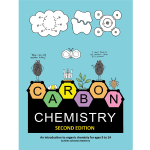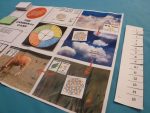- Description
Description
NOTE: If you own the original version of this curriculum and would like an update, contact me via email. ejm.basementworkshop@gmail.com
FREE SAMPLE CHAPTERS:
CarbonChemistry2nd_sample_first three chapters
CarbonChemistry2nd_activity section sample
Description: This curriculum is designed to be a follow-up to “The Elements.” If you’ve finished that curriculum and want even more chemistry, here is a unit all about carbon-based chemistry. The style of the text (including the bits of whimsical humor) are the same as in “The Elements,” but the student text is more substantial (83 pages) and therefore requires more reading. The activities are still very fun and age appropriate. There are games, experiments, cool demonstrations, recipes, songs, a dance, and a skit.
Topics covered: A quick review of what an atom is, three types of atomic models, an overview of the carbon atom and its allotropes (diamond, graphite, buckyballs), introduction to organic chemistry (alkanes, alkenes, alkynes, e.g. methane, propane, butane), refining of crude oil, isomers, saturated and unsatured molecules, functional groups (alcohols, carboxylic acids, aldehydes, ketones, esters, ethers), combination of functional groups (sodium benzoate, nitroglycerin, soap, pheromones), plastics and polymers, rubber and silicon polymers, the carbon oxides (like CO2), calcium carbonate, the carbon cycle, and carbon-14.
(For those of you are “chemistry-shy”, don’t let this list scare you– everything is presented in ways that both you and your student will understand completely. I promise!)
Activities included: A comprehension self-check list of questions for the student at the end of every chapter, some pencil and paper word puzzle activities (crosswords, etc.), plus suggestions for many hands-on activities such as building models of carbon’s allotropes, playing the Organic Molecules Card Game, burning experiments, counting carbons song, paper chain alkanes, make marbled paper, benzene ring dance, the Functional Group Card Game, experiments with acetic acid, isopropanol, and acetone, experiment with soap and surface tension, benzaldehyde snack, recycling plastic relay race, sorting plastics using chemical analysis, experiments with water-absorbing polymers (found in diapers), plastic product testing, the Plastic Song, skit about Charles Goodyear, skewering a balloon, demonstrating molecular motion using a plastic polymer, making “slime,” experiments with Silly Putty, the Carbon Cycle Board Game, and the C-14 Game. (The color game pages are single-sided and can be removed from the book and assembled into game boards. The black and white page patterns will need to be copied.) In addition, there are instructions for how to throw a “polymer party” to wrap up your unit using review games, as well as ideas for snacks and decorating.
Student text portion (first half of book): 80 pages divided into 9 chapters. At the end of each chapter there are comprehension self-check questions and some review word puzzles.




